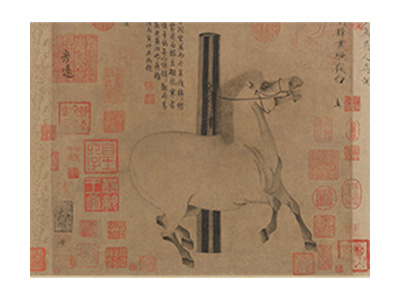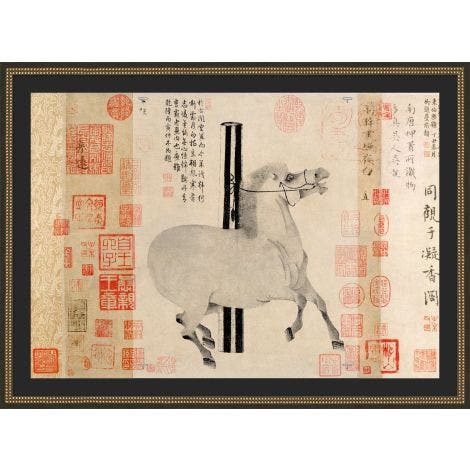Local Storage seems to be disabled in your browser.
For the best experience on our site, be sure to turn on Local Storage in your browser.
Night-Shining White

Our Inspiration: Night-Shining White
Han Gan (Chinese, active ca. 742–756)
Handscroll; ink on paper; ca. 750
Purchase, The Dillon Fund Gift, 1977 1977.78
A leading horse painter of the Tang dynasty, Han Gan was known for capturing not only the likeness of a horse but also its spirit. This painting, the most famous work attributed to the artist, is a portrait of a charger of Emperor Xuanzong (r. 712–56). With its burning eye, flaring nostrils, and dancing hoofs, the fiery-tempered horse epitomizes Chinese myths about Central Asian "celestial steeds" that "sweated blood" and were actually dragons in disguise. The seals and inscriptions added to the painting and its borders by later owners and appreciators are a distinctive feature of Chinese collecting and connoisseurship. The addition of more than 1,000 years of seals and comments offers a vivid testimony of the work's transmission and its impact on later generations.

Our Inspiration: Night-Shining White
Han Gan (Chinese, active ca. 742–756)
Handscroll; ink on paper; ca. 750
Purchase, The Dillon Fund Gift, 1977 1977.78
A leading horse painter of the Tang dynasty, Han Gan was known for capturing not only the likeness of a horse but also its spirit. This painting, the most famous work attributed to the artist, is a portrait of a charger of Emperor Xuanzong (r. 712–56). With its burning eye, flaring nostrils, and dancing hoofs, the fiery-tempered horse epitomizes Chinese myths about Central Asian "celestial steeds" that "sweated blood" and were actually dragons in disguise. The seals and inscriptions added to the painting and its borders by later owners and appreciators are a distinctive feature of Chinese collecting and connoisseurship. The addition of more than 1,000 years of seals and comments offers a vivid testimony of the work's transmission and its impact on later generations.


